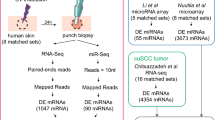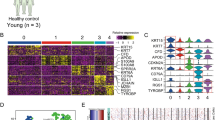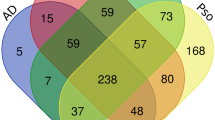Abstract
Chemically induced mouse skin carcinogenesis represents the most extensively utilized animal model to unravel the multistage nature of tumour development and to design novel therapeutic concepts of human epithelial neoplasia. We combined this tumour model with comprehensive gene expression analysis and could identify a large set of novel tumour-associated genes that have not been associated with epithelial skin cancer development yet. Expression data of selected genes were confirmed by semiquantitative and quantitative RT-PCR as well as in situ hybridization and immunofluorescence analysis on mouse tumour sections. Enhanced expression of genes identified in our screen was also demonstrated in mouse keratinocyte cell lines that form tumours in vivo. Self-organizing map clustering was performed to identify different kinetics of gene expression and coregulation during skin cancer progression. Detailed analysis of differential expressed genes according to their functional annotation confirmed the involvement of several biological processes, such as regulation of cell cycle, apoptosis, extracellular proteolysis and cell adhesion, during skin malignancy. Finally, we detected high transcript levels of ANXA1, LCN2 and S100A8 as well as reduced levels for NDR2 protein in human skin tumour specimens demonstrating that tumour-associated genes identified in the chemically induced tumour model might be of great relevance for the understanding of human epithelial malignancies as well.
This is a preview of subscription content, access via your institution
Access options
Subscribe to this journal
Receive 50 print issues and online access
$259.00 per year
only $5.18 per issue
Buy this article
- Purchase on Springer Link
- Instant access to full article PDF
Prices may be subject to local taxes which are calculated during checkout






Similar content being viewed by others
Abbreviations
- BCC:
-
basal cell carcinoma
- DMBA:
-
7,12-dimethylbenz-[α]-anthracene
- ISH:
-
in situ hybridization
- NIA:
-
National Institute of Aging
- NS:
-
normal skin
- PAP:
-
papilloma
- RQ-PCR:
-
real-time quantitative reverse transcription PCR
- RT-PCR:
-
reverse transcription PCR
- SCC:
-
squamous cell carcinoma
- SOM:
-
self-organizing maps
- TPA:
-
12-O-tetradecanoylphorbol-13-acetate
References
Angel P, Szabowski A, Schorpp-Kistner M . (2001). Oncogene 20: 2413–2423.
Arias AM . (2001). Cell 105: 425–431.
Bogenrieder T, Herlyn M . (2003). Oncogene 22: 6524–6536.
Bowden GT . (2004). Nat Rev Cancer 4: 23–35.
Breitenbach U, Tuckermann JP, Gebhardt C, Richter KH, Furstenberger G, Christofori G et al. (2001). J Invest Dermatol 117: 634–640.
Cavallaro U, Schaffhauser B, Christofori G . (2002). Cancer Lett 176: 123–128.
Chen Y, Miller C, Mosher R, Zhao X, Deeds J, Morrissey M et al. (2003). Cancer Res 63: 1927–1935.
Clarke PA, te Poele R, Wooster R, Workman P . (2001). Biochem Pharmacol 62: 1311–1336.
Cromer A, Carles A, Millon R, Ganguli G, Chalmel F, Lemaire F et al. (2004). Oncogene 23: 2484–2498.
Diaz-Guerra M, Haddow S, Bauluz C, Jorcano JL, Cano A, Balmain A et al. (1992). Cancer Res 52: 680–687.
Diehl F, Grahlmann S, Beier M, Hoheisel JD . (2001). Nucl Acids Res 29: E38.
DiGiovanni J . (1992). Pharmacol Ther 54: 63–128.
Dooley TP, Reddy SP, Wilborn TW, Davis RL . (2003). Biochem Biophys Res Commun 306: 1026–1036.
Egeblad M, Werb Z . (2002). Nat Rev Cancer 2: 161–174.
Furstenberger G, Kopp-Schneider A . (1995). Carcinogenesis 16: 61–69.
Gebhardt C, Breitenbach U, Richter KH, Furstenberger G, Mauch C, Angel P et al. (2005). Am J Pathol 167: 243–253.
Gebhardt C, Breitenbach U, Tuckermann JP, Dittrich BT, Richter KH, Angel P . (2002). Oncogene 21: 4266–4276.
Glinsky GV, Ivanova YA, Glinskii AB . (2003a). Cancer Lett 201: 67–77.
Glinsky GV, Krones-Herzig A, Glinskii AB . (2003b). Neoplasia 5: 218–228.
Gogali A, Charalabopoulos K, Constantopoulos S . (2004). Exp Oncol 26: 106–110.
Hu YC, Lam KY, Law S, Wong J, Srivastava G . (2001a). Clin Cancer Res 7: 2213–2221.
Hu YC, Lam KY, Law S, Wong J, Srivastava G . (2001b). Clin Cancer Res 7: 3519–3525.
Huber W, von Heydebreck A, Sultmann H, Poustka A, Vingron M . (2002). Bioinformatics 18(Suppl. 1): S96–S104.
Ishikawa N, Daigo Y, Yasui W, Inai K, Nishimura H, Tsuchiya E et al. (2004). Clin Cancer Res 10: 8363–8370.
Ito N, Hasegawa R, Imaida K, Hirose M, Asamoto M, Shirai T . (1995). Crit Rev Oncol Hematol 21: 105–133.
Kargul GJ, Dudekula DB, Qian Y, Lim MK, Jaradat SA, Tanaka TS et al. (2001). Nat Genet 28: 17–18.
Kerkela E, Saarialho-Kere U . (2003). Exp Dermatol 12: 109–125.
Kettunen E, Anttila S, Seppanen JK, Karjalainen A, Edgren H, Lindstrom I et al. (2004). Cancer Genet Cytogenet 149: 98–106.
Ko MS, Kitchen JR, Wang X, Threat TA, Wang X, Hasegawa A et al. (2000). Development 127: 1737–1749.
Krieg P, Schnapke R, Furstenberger G, Vogt I, Marks F . (1991). Mol Carcinog 4: 129–137.
Leethanakul C, Patel V, Gillespie J, Shillitoe E, Kellman RM, Ensley JF et al. (2000). Oral Oncol 36: 474–483.
Li J, Johnson JA . (2002). Physiol Genomics 9: 137–144.
Lu J, Liu Z, Xiong M, Wang Q, Wang X, Yang G et al. (2001). Int J Cancer 91: 288–294.
Luo A, Kong J, Hu G, Liew CC, Xiong M, Wang X et al. (2004). Oncogene 23: 1291–1299.
Marks F, Furstenberger G . (1990). Carcinogenesis 11: 2085–2092.
Mendez E, Cheng C, Farwell DG, Ricks S, Agoff SN, Futran ND et al. (2002). Cancer 95: 1482–1494.
Nagata M, Fujita H, Ida H, Hoshina H, Inoue T, Seki Y et al. (2003). Int J Cancer 106: 683–689.
Nair KS, Naidoo R, Chetty R . (2005). J Clin Pathol 58: 343–351.
Patil MA, Chua MS, Pan KH, Lin R, Lih CJ, Cheung ST et al. (2005). Oncogene 24: 3737–3747.
Petroziello J, Yamane A, Westendorf L, Thompson M, McDonagh C, Cerveny C et al. (2004). Oncogene 23: 7734–7745.
Rennecke J, Rehberger PA, Furstenberger G, Johannes FJ, Stohr M, Marks F et al. (1999). Int J Cancer 80: 98–103.
Rundhaug JE, Gimenez-Conti I, Stern MC, Budunova IV, Kiguchi K, Bol DK et al. (1997). Mol Carcinogen 20: 125–136.
Schlingemann J, Hess J, Wrobel G, Breitenbach U, Gebhardt C, Steinlein P et al. (2003). Int J Cancer 104: 699–708.
Stern MC, Duran HA, McKenna EA, Conti CJ . (1997). Mol Carcinogen 20: 137–142.
Strickland JE, Greenhalgh DA, Koceva-Chyla A, Hennings H, Restrepo C, Balaschak M et al. (1988). Cancer Res 48: 165–169.
Tamayo P, Slonim D, Mesirov J, Zhu Q, Kitareewan S, Dmitrovsky E et al. (1999). Proc Natl Acad Sci USA 96: 2907–2912.
Tanaka TS, Jaradat SA, Lim MK, Kargul GJ, Wang X, Grahovac MJ et al. (2000). Proc Natl Acad Sci USA 97: 9127–9132.
Tsai WC, Tsai ST, Ko JY, Jin YT, Li C, Huang W et al. (2004). Oral Oncol 40: 418–426.
Wrobel G, Schlingemann J, Hummerich L, Kramer H, Lichter P, Hahn M . (2003). Nucl Acids Res 31: e67.
Young MR, Nair R, Bucheimer N, Tulsian P, Brown N, Chapp C et al. (2002). Mol Cell Biol 22: 587–598.
Young MR, Yang HS, Colburn NH . (2003). Trends Mol Med 9: 36–41.
Yuspa SH . (1998). J Dermatol Sci 17: 1–7.
Acknowledgements
We thank Gunnar Wrobel, Bjoern Tews and Grischa Toedt for statistical and IT support as well as Ingeborg Vogt, Inga Ruiner, Heidi Kramer and Daniela Bodemer for technical assistance. This study was supported by the German Ministry for Education and Research (National Genome Research Network, NGFN-1, 01 GR 0101, NGFN-2, 01 GS 0460) to PL and MH, the Deutsche Forschungsgemeinschaft (AN 182/8-2), by the Research Training Network (RTN) Program of the European Community to PA and the Centre of Molecular Medicine, University of Cologne (BMFT/IDZ 10, Grant 01 GB 950/4) to CM.
Author information
Authors and Affiliations
Corresponding author
Additional information
Supplementary Information accompanies the paper on Oncogene website (http://www.nature.com/onc)
Rights and permissions
About this article
Cite this article
Hummerich, L., Müller, R., Hess, J. et al. Identification of novel tumour-associated genes differentially expressed in the process of squamous cell cancer development. Oncogene 25, 111–121 (2006). https://doi.org/10.1038/sj.onc.1209016
Received:
Revised:
Accepted:
Published:
Issue Date:
DOI: https://doi.org/10.1038/sj.onc.1209016
Keywords
This article is cited by
-
The STK38–XPO1 axis, a new actor in physiology and cancer
Cellular and Molecular Life Sciences (2021)
-
Ndr kinases regulate retinal interneuron proliferation and homeostasis
Scientific Reports (2018)
-
RETRACTED ARTICLE: Expression and prognostic value of the aldehyde dehydrogenase 1 (ALDH1) and N-myc downstream regulated gene 2 (NDRG2) as potential markers in human astrocytomas
Tumor Biology (2016)
-
Age-associated inflammation connects RAS-induced senescence to stem cell dysfunction and epidermal malignancy
Cell Death & Differentiation (2015)
-
A Transposon-Based Analysis of Gene Mutations Related to Skin Cancer Development
Journal of Investigative Dermatology (2013)



